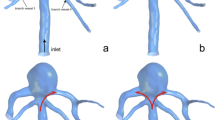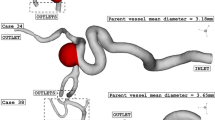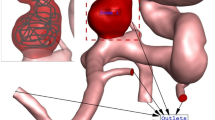Abstract
Intra-aneurysmal hemodynamics such as wall shear stress and complex flow structures have been implicated as one of the important factors on the growth and risk of rupture of an aneurysm. In this study, the sensitivity of intra-aneurysmal blood flow dynamics to the shear-thinning rheological model is investigated by using the idealized geometries of a basilar tip aneurysm with two representative anterior-posterior (AP) tilting angles (2° and 30°). By choice of different rheological models, time-averaged hemodynamic factors such as wall shear stress, oscillatory shear index and relative residence time exhibited only minor effects. However, highly unstable flow present in idealized aneurysm model with 2° AP tilting angle facilitated an evident change in the instantaneous local flow dynamics with a considerable increase in effective viscosity. Nevertheless, the distinct hemodynamic phenotype, which characterizes the gross intraaneurysmal flow pattern, was independent of the choice of rheological model. This result suggests that the shear thinning viscous effect is of secondary importance in the gross hemodynamics in a basilar tip aneurysm but is appreciably enhanced on the instantaneous hemodynamics with unstable complex flow structures.
Similar content being viewed by others
References
G. Rinkel, M. Djibuti, A. Algra and J. van Gijn, Prevalence and risk of rupture of intracranial aneurysms: a systematic review, Stroke, 29 (1998) 251–256.
D. Wiebers, J. Whisnant, J. Huston, I. Meissner, R. Brown, D. Piepgras, G. Forbes and K. Thielen et al., Unruptured intracranial aneurysms: natural history, clinical outcome, and risks of surgical and endovascular treatment, Lancet, 362 (2003) 103–110.
T. Ishibashi, Y. Murayama, M. Urashima, T. Saguchi, M. Ebara, H. Arakawa, K. Irie, H. Takao and T. Abe, Unruptured intracranial aneurysms: incidence of rupture and risk factors, Stroke, 40 (2009) 313–316.
D. A. Steinman, J. Milner, C. Norley, S. Lownie and D. Holdsworth, Image-based computational simulation of flow dynamics in a giant intracranial aneurysm, AJNR Am. J. Neuroradiol., 24 (2003) 559–566.
Y. Hoi, H. Meng, S. Woodward, B. Bendok, R. Hanel, L. Guterman and L. Hopkins, Effects of arterial geometry on aneurysm growth: three-dimensional computational fluid dynamics study, J. Neurosurg., 101 (2004) 676–681.
A. Valencia, A. Guzman, E. Finol and C. Amon, Blood flow dynamics in saccular aneurysm models of the basilar artery, J. Biomech. Eng., 128 (2006) 516–526.
J. Cebral, M. Castro, J. Burgess, R. Pergolizzi, M. Sheridan and C. Putman, Characterization of cerebral aneurysms for assessing risk of rupture by using patient-specific computational hemodynamics models, AJNR Am. J. Neuroradiol., 26 (2005) 2550–2559.
D. Sforza, C. Putman, E. Scrivano, P. Lylyk and J. Cebral, Blood-flow characteristics in a terminal basilar tip aneurysm prior to its fatal rupture, AJNR Am. J. Neuroradiol., 31 (2010) 1127–1131.
M. Ford, S. Lee, S. Lownie, D. Holdsworth and D. A. Steinman, On the effect of parent-aneurysm angle on flow patterns in basilar tip aneurysms: towards a surrogate geometric marker of intra-aneurismal hemodynamics, J. Biomech., 41 (2008) 241–248.
B. Johnston, P. Johnston, S. Corney and D. Kilpatrick, Non-Newtonian blood flow in human right coronary arteries: steady state simulations, J. Biomech., 37 (2004) 709–720.
S. Lee and D. A. Steinman, On the relative importance of rheology for image-based CFD models of the carotid bifurcation, J. Biomech. Eng., 129 (2007) 273–278.
S. O’Callaghan, M. Walsh and T. McGloughlin, Numerical modeling of Newtonian and non-Newtonian representation of blood in a distal end-to-side vascular bypass graft anastomosis, Med. Eng. Phys., 28 (2006) 70–74.
K. Perktold, M. Resch and H. Florian, Pulsatile non-Newtonian flow characteristics in a three-dimensional human carotid bifurcation model, J. Biomech. Eng., 113 (1991) 464–475.
M. Ford, G. Stuhne, H. Nikolov, D. Habets, S. Lownie, D. Holdsworth and D. W. Steinman, Virtual angiography for visualization and validation of computational models of aneurysm hemodynamics, IEEE Trans. Med. Imaging., 24 (2005) 1586–1592.
C. Ethier, D. A. Steinman and M. Ojha, Comparisons between computational hemodynamics, photochromic dye flow visualization and magnetic resonance velocimetry. In: The haemodynamics of arterial organs-comparisons of computational predictions with in vivo and in vitro data, edited by X. Y. Xu and M. W. Collins. WIT Press (1999) 131–183.
C. Ethier, S. Prakash, D. A. Steinman, R. Leask, G. Couch and M. Ojha, Steady flow separation patterns in a 45 degree junction, J. Fluid. Mech., 411 (2000) 1–38.
P. Minev and C. Ethier, A characteristic/finite element algorithm for the 3-D Navier-Stokes equations using unstructured grids, Comp. Meth. App. Mech. Eng., 178 (1998) 39–50.
F. Gijsen, E. Allanic, F. van de Vosse and J. Janssen, The influence of the non-Newtonian properties of blood on the flow in large arteries: unsteady flow in a 90 degrees curved tube, J. Biomech., 32 (1999) 705–713.
T. Seo, L. Schachter and A. Barakat, Computational study of fluid mechanical disturbance induced by endovascular stents, Ann. Biomed. Eng., 33 (2005) 444–456.
S. Chien, S. Usami, H. Taylor, J. Lundberg and M. Gregersen. Effects of hematocrit and plasma proteins on human blood rheology at low shear rates, J. App. Phys., 21 (1996) 81–87.
P. Ballyk, D. Steinman and C. Ethier, Simulation of nonnewtonian blood flow in an end-to-side anastomosis, Biorheology, 31 (1994) 565–586.
F. Walburn and D. Schneck, A constitutive equation for whole human blood, Biorheology, 13 (1976) 201–210.
G. Biro, Comparison of acute cardiovascular effects and oxygen-supply following haemodilution with dextran, stroma-free haemoglobin solution and fluorocarbon suspension, Cardiovasc. Res., 16 (1982) 194–204.
H. Himburg, D. Grzybowski, A. Hazel, J. LaMack, X. Li and M. Friedman, Spatial comparison between wall shear stress measures and porcine arterial endothelial permeability, Am. J. Physiol. Heart. Circ. Phys., 286 (2004) H1916–1922.
S. Lee, L. Antiga and D. Steinman, Correlations among indicators of disturbed flow at the normal carotid bifurcation, J. Biomech. Eng., 131 (2009) 061013.
M. Ohta, S. Wetzel, P. Dantan, C. Bachelet, K. Lovblad, H. Yilmaz, P. Flaud and D. Rufenacht, Rheological changes after stenting of a cerebral aneurysm: a finite element modeling approach, Intervent. Radiol., 28 (2005) 768–772.
V. Rayz, L. Boussel, M. Lawton, G. Acevedo-Bolton, L. Ge, W. Young, R. Higashida and D. Saloner, Numerical modeling of the flow in intracranial aneurysms: prediction of regions prone to thrombus formation, Ann. Biomed. Eng., 36 (2008) 1793–1804.
L. Jou, D. Lee, H. Morsi and M. Mawad, Wall shear stress on ruptured and unruptured intracranial aneurysms at the internal carotid artery, AJNR Am. J. Neuroradiol., 29 (2008) 1761–1767.
M. Castro, C. Putman, M. Sheridan and J. Cebral, Hemodynamic patterns of anterior communicating artery aneurysms: a possible association with rupture, AJNR Am. J. Neuroradiol., 30 (2009) 297–302.
H. Steiger, R. Aaslid, S. Keller and H. Reulen, Strength, elasticity and viscoelastic properties of cerebral aneurysms, Heart Vessels, 5 (1989) 41–46.
K. Hayashi, H. Handa, S. Nagasawa, A. Okumura and K. Moritake, Stiffness and elastic behavior of human intracranial and extracranial arteries, J. Biomech., 13 (1980) 175–184.
Author information
Authors and Affiliations
Corresponding author
Additional information
Recommended by Associate Editor Do Hyung Lee
S.-W. Lee received his Ph.D. degree in Mechanical Engineering from the University of Illinois at Chicago in 2005. Currently, he is an associate professor of the School of Mechanical Engineering at the University of Ulsan. His research interests include cardiovascular mechanics, biofluid dynamics and numerical simulation.
Rights and permissions
About this article
Cite this article
Lee, SW. On the effect of shear-thinning rheology on hemodynamic characteristics in basilar tip aneurysms with implication of two distinct flow patterns. J Mech Sci Technol 26, 3125–3132 (2012). https://doi.org/10.1007/s12206-012-0821-9
Received:
Revised:
Accepted:
Published:
Issue Date:
DOI: https://doi.org/10.1007/s12206-012-0821-9




